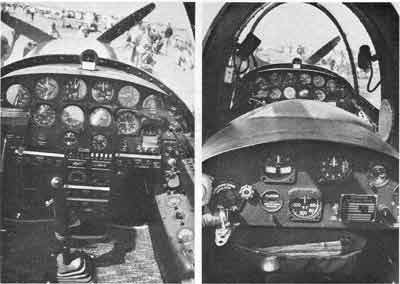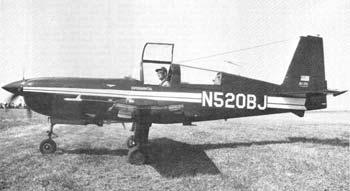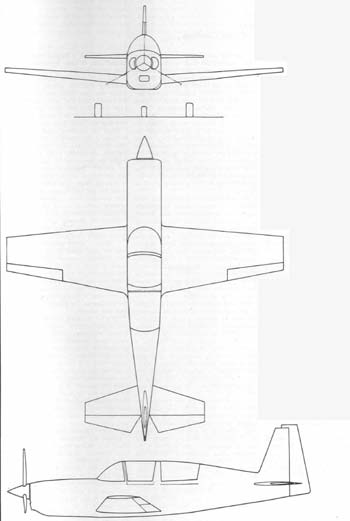Doc Brokaw's Blue
Bullet: "Pure Mean With Wings" |
PAGE TWO
The control pressures are not featherlight, but at that speed you wouldn't want them to be. They have enough feel to let you know that the airplane's sitting right in the palm of your hand. The response, in all axes, especially roll, is immediate and precise. You can flash into a 60-degree bank and stop so hard it'll slam your eyeballs to one side. You can snatch it up out of level flight and do rolls until you're tired of holding the stick to. one side. I got so enthusiastic once that I forgot to warn the doctor about an upcoming four-point roll. I heard him yelp in surprise as I hung him from his belt on the back side. Sorry about that, Doc. The BJ has been flown inverted for periods of up to one minute. Roll rate is about 180 degrees a second, and norudder aileron rolls barely budge the ball. The stalls are not as bad as you'd expect from such tiny, hardworking wings. Clean at around 88 mph, it shakes and buffets for just a second before the wing unloads pretty sharply. Drop the nose, punch the power and you're flying again. With everything hanging out, the stalls drop to around 75 mph indicated (we were light on fuel) and it is a bit more stable with less tendency to roll off during the break. The warning buffet is short, but it leaves no doubt that you're about to step into something stupid. As I was preparing to let back down into the pattern, I decided to see exactly how 78 square feet of wing area felt with the power off. I expected it to not even bother gliding and assume a ballistic path towards the ground. I was right in expecting it to come down quickly, it gave about 2500 fpm, gear and flaps up, but I'd forgotten how clean it is. Even though we were losing altitude at a terrifying rate, we were coasting one hell of a long way in the process. You'd have a pretty fair radius of action to work in should the horsepower factory up front pack it in.
As soon as I dirtied it up, the glide angle became something to tell the boys at the bar about. At an approach speed of 110 mph, power off, it had the aerodynamic qualities of a clump of grass. I don't know what our L/D was, but we didn't appear to move a foot forward for each one we moved down. (And it's moving down in a hurry, nearly 5000 fpm.) After tiptoeing around in the BJ's flight envelope, it was time to go back and see if we could get this hose-nosed thing on the ground. I brought the power back and spiraled down to pattern altitude, showing about 3,000 fpm down on the VSI in the process. I leveled out and began easing the power in as I came on to downwind leg, monitoring the manifold pressure without really thinking too much about it. Then, it suddenly dawned on me...the manifold pressure was moving a lot faster than my throttle hand. I stopped moving the throttle but the manifold pressure kept building. For a split second I couldn't figure out what was going on. Then it hit me. The reason the manifold pressure was heading up towards the local barometric pressure of about 29 inches was because the engine wasn't running. In a calm but slightly squeaky voice, I announced, "Hey, Doc. I hate to tell you, but this thing isn't running." Up to that moment he had been slouched in the seat, enjoying the ride; now he jerked bolt upright, fiddling with the throttle as he grabbed for something on the floor. We were at 600 feet. At our sink rate, I figured Doc had 8 seconds to pull something out of his hat. The jolt of power that surged through the airframe gave me back the ten years I had just lost. The doctor smiled sheepishly and admitted that he had no gauges on the leading edge fuel tanks and we had just run them dry. Thanks, Doc. You just about had a cardiac case on your hands. The magic number on final is 110 mph, and judging from what I'd seen earlier, I knew that the sink rate would really be exciting if the speed got much below that number. As it is, a fair amount of power is needed to keep the glide path from approaching vertical. It doesn't bob, weave, or even wiggle and the initial feeling is one of flying a simulator with a moving picture screen over the nose. You just keep the airspeed nailed on 110 mph, which is no problem because the BJ is so stable in pitch, and jockey the power to come down where you want it. This stable feeling is partially a function of that high wing loading; it doesn't ride over thermals, it punches through them. Naturally, it's not what you would call a floater, although when I began to bring the nose up, the sink rate stopped immediately, indicating that at 110 mph you've still got plenty of lift in the bank. As the nose came up, the throttle came back and we thumped onto the runway to roll out with the nose still in the air, Navy style. With fairly heavy braking, we used about 1600 feet of concrete, which pretty well justified Brokaw's claim that he could operate out of just about any paved 3,000foot strip. But if a runway was going to be much shorter, say down to 2,000 feet, the approaches would have to be mighty clear. As with most people blessed with his type of ambition, the Doctor is not satisfied with his airplane. He wants to extend the 75 percent cruise range from its present 625 miles (with a 45minute reserve) to 1,000 miles or better, so you'll eventually be seeing the BJ with tip tanks. That'll mean a new wing, but the Doctor doesn't mind because he thinks he could build a much lighter and cleaner one the second time around. He also said he could use some more power, so he's looking into a 380 hp Lycoming engine. Some extra weight would be useful up front because that would allow him to shorten the nose, a design problem that surfaced after he had the airframe too near completion to change. As it is, the BJ's aft center-of-gravity limit is just over the mainwheels. If you load it out of balance to the rear, the airplane will tell you by lifting its nosewheel off the ground. Asked what his next airplane is going to be, Brokaw answers, "This one isn't nearly as fast as we can make it. Wait until we get the 520 up to speed, then I'll start working on something else." By the time this goes into print, plans and information packets for the BJ520 will be finished and for sale, but don't get excited and rush for your checkbook. For one thing, Brokaw says he's being just a little selective as to whom he sells plans. He recognizes that while the BJ is in no way difficult to fly, it is a highperformance airplane in every sense of the word and it must be flown like one. You have to fly it strictly by the numbers and respect the high wing loading and approach speeds. Also, bear in mind that little goodies like TSIO-520s are not cheap. A project like the BJ520 isn't something to be taken lightly. The first one took six and a half years to complete at a price even Brokaw doesn't want to tally up. However, the plans are absolutely professional-quality shop drawings and answer practically every question any builder could possibly have. Here too, however, the price isn't low... you need 250 of Uncle Sam's inflated dollars to join the BJ520 club. I asked Doctor Brokaw why he should want to take on the headaches
of selling plans (Jones sells the information packets). He obviously
doesn't need the money. And, if I were him, I would want to keep my
airplane to myself. He answered, "I've had hundreds of people
send money for information packets so it seems I'm not the only one
that wants to go fast." SPECIFICATIONS
Length .................................. 22 ft 9 in |


